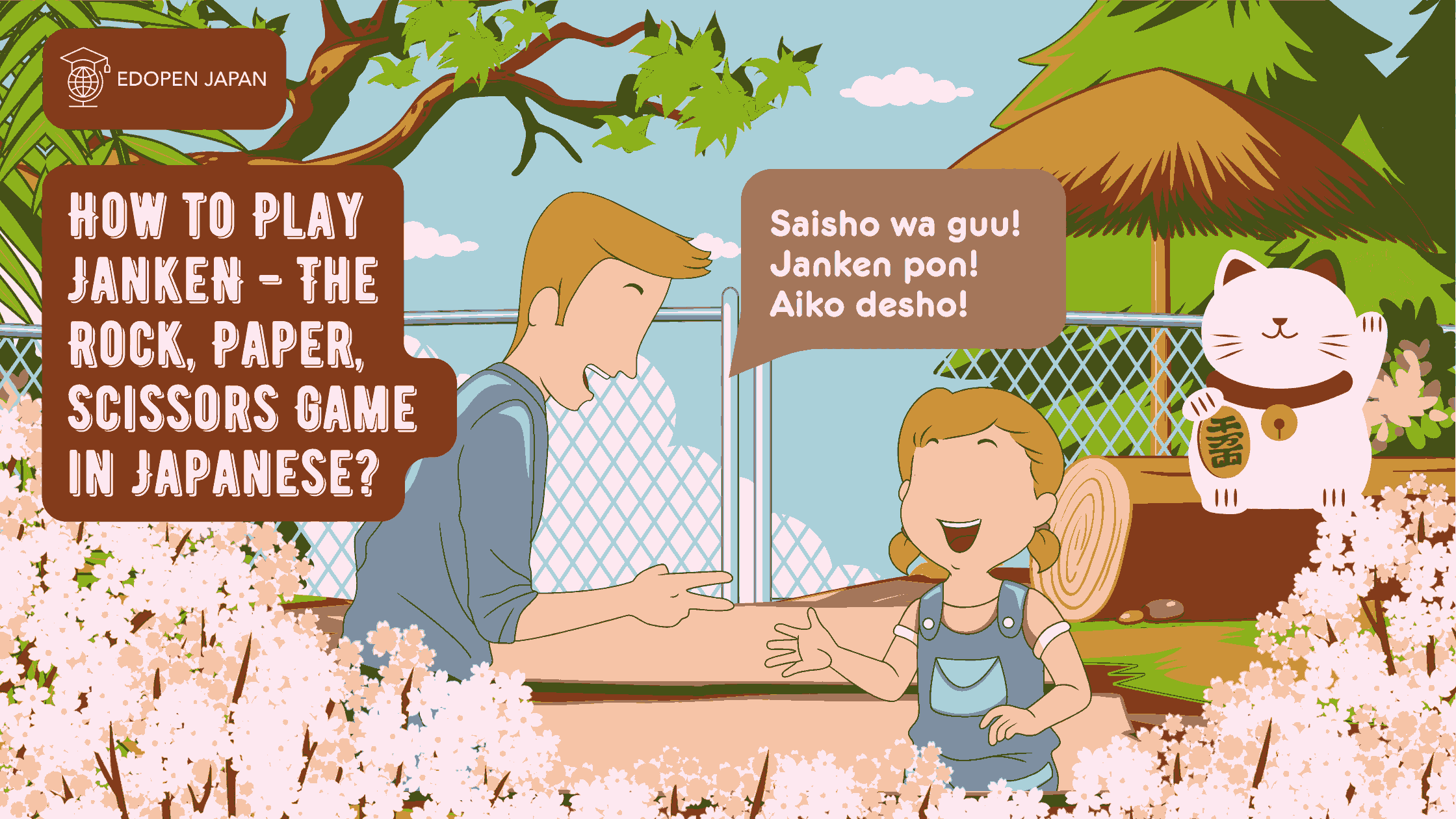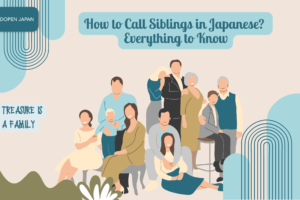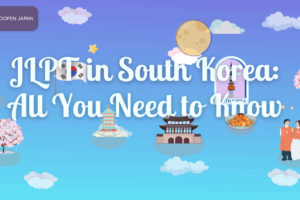Have you heard of “Janken” before? But in Japan, Janken is a big deal and is used frequently in many situations. When visiting Japan, you’ll likely hear this word often. If you need to make a small decision, like who gets the last slice of pizza or who gets to ride shotgun, you’re probably familiar with the game of rock, paper, and scissors.
Rock, Paper, Scissors – also known as “Janken” in Japan – had gained popularity in Japan long before it became known in the Western world. In this article, we will provide an in-depth guide to this fascinating game. Keep reading to learn everything you need to know!
In addition, for comprehensive and reliable references on learning Japanese, including common phrases used in daily conversations in Japan, please check out our recommended readings below.
Read also:
8 Most Popular Manga to Learn Japanese
10 Most Great Japanese Novels for Beginners!
The Cutest Japanese Phrases You Need to Know
Contents
What is Janken (じゃんけん)?
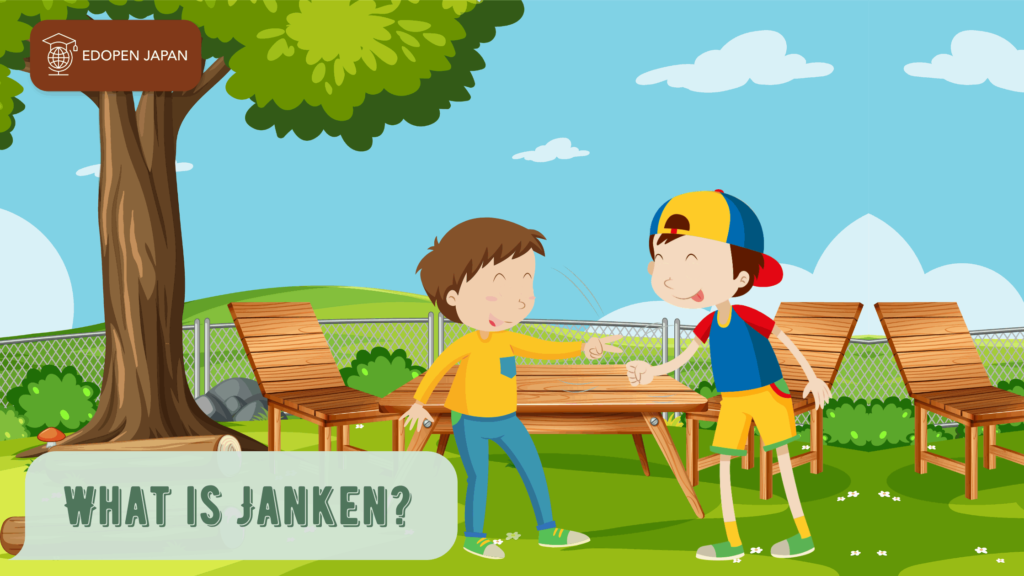
Janken is a game played similarly to the widely known American game, rock-paper-scissors. To aid in understanding, refer to the helpful chart below. In Janken, players choose one of three moves to use against their opponent. The rock beats the scissors, the scissors cut the paper, and the paper covers the rock.
In Japan, different names are used to refer to these moves. Obviously, in the Japanese context, different terminology is used. Please refer to the following table for clarification.
| English | Roman | Japanese |
|---|---|---|
| Rock | Gu- | グー |
| Paper | Pa- | パー |
| Scissors | Choki | チョキ |
There are additional differences to note regarding the game “Janken.” The game adheres to a specific ritual where both players begin by saying “Saisho wa guu” (meaning “Starting with rock” in English) while making a closed fist.
Afterward, both players say “Janken pon!” and simultaneously reveal their turn, whether it’s rock, paper, or scissors. In the event of a tie (when both players choose the same move), they both say”Aiko desho!” (aiko あいこ), or “It appears to be a tie!” The game continues in rapid succession until someone wins.
However, Janken has numerous variations. In Japan, “rock-paper-scissors” is known as “Janken (じゃんけん)”. Although the name may vary by location, the rules of the game are generally consistent across countries. In Japan, “Janken” is utilized to resolve disputes, determine participants, and establish order.
The Rules of Janken (じゃんけん)
The guidelines and hand movements for the Japanese version of rock-paper-scissors mirror those of the American version. A closed fist represents the rock, two extended fingers symbolize the scissors, and an open palm facing downward signifies the paper. The rock beats the scissors, the scissors cut the paper, and the paper covers the rock.
In the Japanese version of the game, the hand sign for rock is referred to as “Gu-” (グー), while the hand sign for scissors is called “Choki” (チョキ) and the hand sign for paper is called “Pa-” (パー). The game is played similarly to the popular game of “rock scissors paper”.
The terms “Gu-”, “Choki”, and “Pa-” are used interchangeably with rock, scissors, and paper respectively. During the game of “Janken”, “Gu-” beats “Choki”, “Choki” beats “Pa-” and “Pa-” beats “Gu-”. In the event of a tie, it is called an “Aiko” (あいこ).
The Example of How to Play “Janken”
Interestingly, these are not the actual names of the objects, but rather the sounds designated to represent certain actions. For instance, squeezing your hand is represented by the sound guu, cutting something with scissors by choki, and opening your hand by paa. Although the principle is constant, the chant itself is different. To begin, perform the rock gesture and pump your fists while uttering “Saisho wa guu” (さいしょはグー).
Translated literally, the phrase “First is Rock” describes the opening move in the game of rock-paper-scissors. Another variation of this phrase is “Saisho Gu-” which omits the “wa”. Following this line is the command “Janken pon!” (じゃんけんぽん!), after which both players reveal one of three hand gestures – “rock,” “scissors,” or “paper”. In the event of a tie, both players repeat the phrase “Aiko desho!” (あいこでしょ!), meaning “It’s a draw, isn’t it?”, and then show their hands again on the “sho!” prompt.
Then, in the event of another tie, this last line is repeated until a victor is determined. The steps of Janken (じゃんけん) can be described as follows:
(Step 1) Saisho wa guu
(Step 2) Janken pon!
When it’s a draw, say:
(Step 3) Aiko desho!
The History of Janken (じゃんけん)
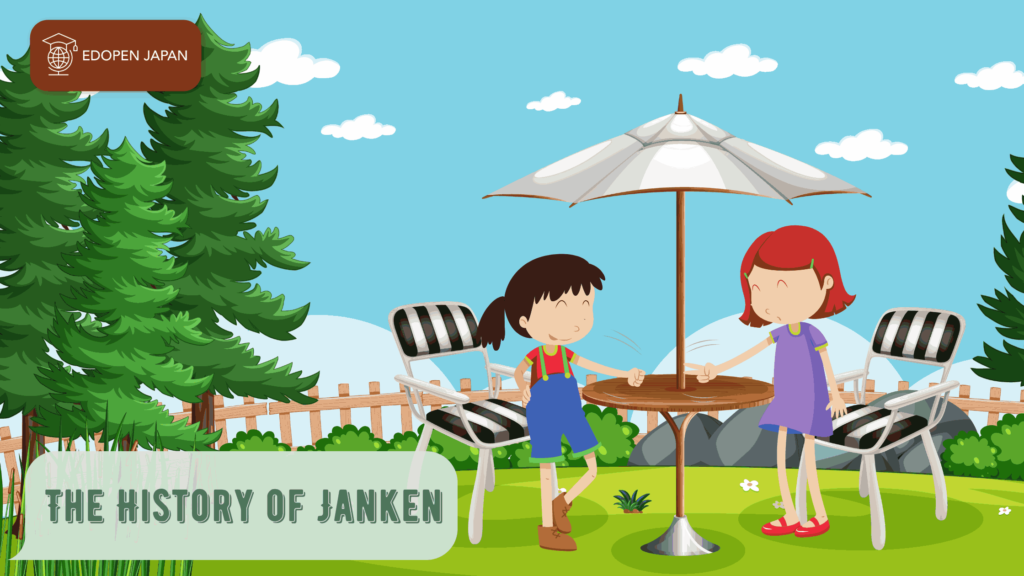
“Rock-paper-scissors” has the origin in China, or at least that is where the first historical mention of the game comes from. The book Wuzazu documents the first mention of a similar game called Shoushiling. According to the book, the game began during the Han Dynasty (202 BC – 220 AD).
A similar game to Shoushiling is mentioned repeatedly in Japanese history and became known as sansukumi-ken, which means “triple standstill” with “ken” referring to “fist”.
Several versions of Sansukumi-ken exist, with the first being mushi-ken directly derived from China. Unlike rock, paper, and scissors, mushi-ken uses a frog, a snail, and a snake to represent the three choices, respectively indicated by extending the little finger, thumb, or index finger from the fist.
In Western societies, “Janken” is sometimes employed for minor decision-making, but the Japanese have likely established it as a longstanding type of social engagement with the introduction of “kitsune-ken,” which follows a comparable set of regulations.
Janken (じゃんけん) as a useful solution
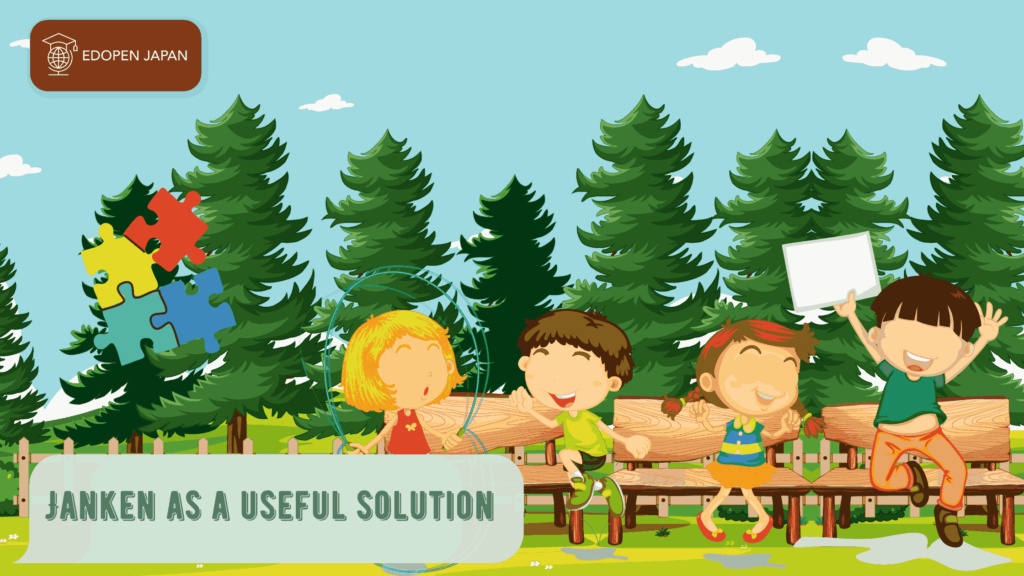
“Janken” offers a straightforward and impartial solution to various social dilemmas that persist into adulthood. Rock-paper-scissors contests are utilized to settle everything from footing the bill at dinner to determining who receives the shiny new iPhone at end-of-the-year office parties.
In some circumstances, even expensive transactions are concluded through a game of “Janken,” as demonstrated by this auction house that resolved a tie between bidders in this very manner.
1. Japanese School Children and Janken (じゃんけん)
Children in Japan learn “Janken” at a young age. It serves as a simple and efficient method for parents to resolve sibling disputes through the impartial hand of luck. “Janken” is also commonly used in Japanese classrooms to determine who goes first or in what order activities are to be carried out. Thus, children respect the decision since they perceive it as fair and based on their own decisions in the game.
Furthermore, “Janken” is a crucial factor for individuals teaching in Japan or desiring to learn further about the Japanese culture. If foreign language instruction is being taught, instruct students to play the game in the language they are learning, and it will instantly become an educational and enjoyable cultural activity.
2. Japanese Janken (じゃんけん) for Adults
Many people may consider the Japanese game of rock-paper-scissors to be a game solely for children, and think that individuals stop playing it as they mature and realize that life is not always straightforward. However, this notion is incorrect. “Janken” is a game that is played throughout Japanese society.
Although adults do not play it throughout the day like children do, they utilize it to make determinations such as who will pay for the next round of drinks, who will attend the business trip, who will deliver the presentation, who will disclose the mistake in last month’s budget to the boss, and even in important business decisions.
3. Janken (じゃんけん) in the Business World
“Janken” is deeply embedded in Japanese culture, and its influence can be seen in many aspects of daily life. For example, restaurants and bars frequently feature promotions that require customers to play “Janken” with their servers to receive a free drink or a discount.
Additionally, “Janken” is a common drinking game among friends, and the rules for breaking a tie or winning can vary widely. At least one university has invested significant resources and effort into creating a robotic arm that consistently wins “Janken” games with a 100% success rate.
A widely cited example of rock-paper-scissors in the Japanese business world involves Takashi Hashiyama, the CEO of a prosperous Japanese electronics company. In 2005, he sought to sell his collection of paintings by renowned artists such as Cézanne, Picasso, and Van Gogh.
Faced with the dilemma of choosing between two major auction houses that were vying for the contract, Hashiyama resolved to avoid dividing the collection and instead asked the two houses to compete in Janken to decide the matter. The victorious firm subsequently auctioned off the collection for a sum of $20 million, netting millions of dollars in commissions.
About Janken in Different Regions throughout Japan
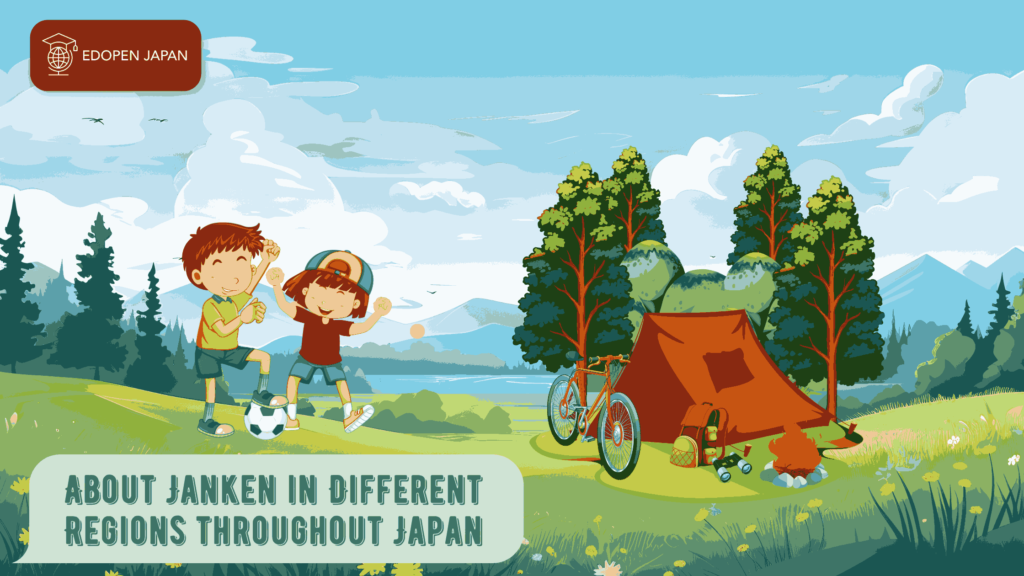
Interestingly, the term “Janken” varies across different regions of Japan. This article aims to familiarize you with the unique way of referring to “Janken.” Multiple exclamations are available, but we will focus on the most prevalent rock-paper-scissors exclamations.
| English | Japanese | Region |
|---|---|---|
| Jan ken pon | じゃんけんぽん | Tokyo |
| Chi ke ta | ちっけった | Chiba |
| Chi chi po | ちーちっぽ | Gunma |
| In jan hoi | いんじゃんほい | Kansai Area |
| Jan ken sho | じゃんけんしょ | Hokkaido |
About Janken (じゃんけん) Nowadays

Like in several other nations, many games in Japan involve playing janken. What are some famous games that make use of janken? See below.
1. The Popular Games Used “Janken (じゃんけん)”
In Japan, numerous games involve the use of “Janken”. In this text, I will introduce some of these games. The most renowned game using “Janken” is “Acchimuite-Hoi” [the Look Away Challenge]. To play it, you have to point in one of four directions: up, down, left, or right.
At the same time, your friend also has to look in one of these four directions. You win if your friend looks in the same direction as you. Other famous games in Japan that include “Janken” are “Glico” and “Tataite-Kabutte Jankenpon”.
2. The “Otokogi-Janken“
It is a game where the winner treats their opponent following a round of rock-paper-scissors, with the victor covering the full cost of food and beverages or other items. The winner then appears on the variety show “Thank you to everyone in Tonnezu,” which garnered significant attention among young people when it was broadcast in September 2011.
“What was that? Janken is deeply ingrained in Japanese culture and manifests itself in various contexts. It serves as a straightforward and impartial resolution to manifold social predicaments that persist throughout adulthood. Having mastered the intricacies of Janken, it is now time to put your skills to the test!” Not merely a game, it exemplifies the influence of Japanese culture and bears significant connotations.
Summary
- “Janken” presents a straightforward and impartial resolution to numerous social dilemmas that arise in daily life. It is an essential tool for individuals seeking to teach in Japan or gain a more comprehensive understanding of Japanese culture. “Janken” is ubiquitous in Japanese society due to its deep roots in Japanese culture. The game’s prevalence can be observed in various contexts throughout Japan.
- Rock-paper-scissors apparently originated in China and developed from a game called “San-juen-zi” or “three-way stop.” The objective of the game is to choose one of three options – rock, paper, or scissors – which can either beat or be beaten by the other player’s choice.
- The name for “Janken” differs across various regions in Japan. In Japan, various Janken-based games have become quite popular, including “Acchi Muite-Hoi” and “Glico”.

